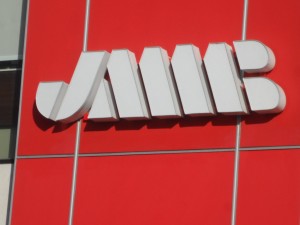
JMMB Group closed at a 52 weeks’ high on Wednesday.
At the close 4,936,602 units valued at $80,553,639, changed hands, compared to 1,458,426 units valued at just $21,510,810 changing hands on Tuesday. The junior market accounted for 1,995,508 units valued at $10,428,547 of the stocks traded.
At the close, the JSE Market Index lost 619.07 points to end at 166,445.68.
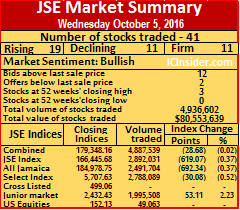 The all Jamaica Composite Index fell 692.34 points to close at 184,978.75 and the JSE combined index slipped 28.68 points, to end at 179,348.16.
The all Jamaica Composite Index fell 692.34 points to close at 184,978.75 and the JSE combined index slipped 28.68 points, to end at 179,348.16.IC bid-offer Indicator| At the end of trading, in the main and junior markets, the Investor’s Choice bid-offer indicator reading shows 12 stocks with bids higher than their last selling prices and 2 with lower offers.
In market activity, Berger Paints traded 49,851 shares and gained 10 cents to close at a 52 weeks’ high of $5.60, Cable & Wireless gained 3 cents to close at 90 cents with 18,516 units trading, Caribbean Cement rose 50 cents in trading 201,487 shares to close at $30.50, Carreras dropped $1 with 74,889 shares changing hands at $65. Trading in 1834 Investments ended with 31,636 shares changing hands to close at $1.24, Grace Kennedy closed with 11,459 shares changing hands at $42.45 after falling 5 cents, Jamaica Producers ended with 40,200 shares changing hands as the price gained 30 cents to close at $8.40. JMMB Group climbed $1.01 in trading 91,100 units to close at a 52 weeks’ high of $14.01, Mayberry Investments traded 973,100 shares to close at $3.70,
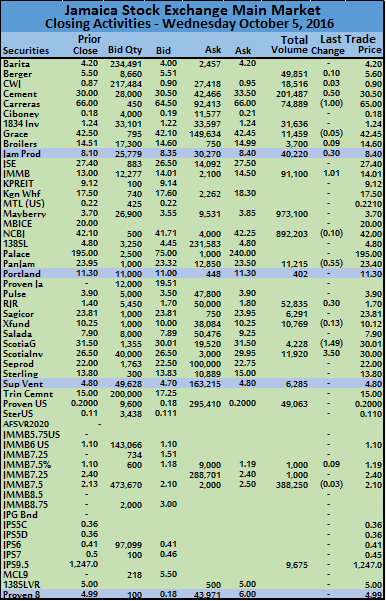 National Commercial Bank traded 892,203 shares and declined 10 cents to end at $42, Pan Jamaican Investments lost 55 cents and closed at $23.40 after trading 11,215 shares. Radio Jamaica gained 30 cents in trading 52,835 shares to close at $1.70, Sagicor Group traded 6,291 shares and ended at $23.81, Sagicor Real Estate Fund traded 10,769 shares but fell 13 cents to close at $10.12, Scotia Group dropped $1.49 and closed at $30.01 with 4,228 shares changing hands. Scotia Investments jumped $3.50 with 11,920 units changing hands to close at $30, Proven Investments traded 49,063 shares at 20 US cents, Jamaica Money Market Brokers 7.50% preference share traded 388,250 units at $2.10 after falling 3 cents and Jamaica Public Service 9.5% preference share traded 9,675 units at $1,247 each.
National Commercial Bank traded 892,203 shares and declined 10 cents to end at $42, Pan Jamaican Investments lost 55 cents and closed at $23.40 after trading 11,215 shares. Radio Jamaica gained 30 cents in trading 52,835 shares to close at $1.70, Sagicor Group traded 6,291 shares and ended at $23.81, Sagicor Real Estate Fund traded 10,769 shares but fell 13 cents to close at $10.12, Scotia Group dropped $1.49 and closed at $30.01 with 4,228 shares changing hands. Scotia Investments jumped $3.50 with 11,920 units changing hands to close at $30, Proven Investments traded 49,063 shares at 20 US cents, Jamaica Money Market Brokers 7.50% preference share traded 388,250 units at $2.10 after falling 3 cents and Jamaica Public Service 9.5% preference share traded 9,675 units at $1,247 each.
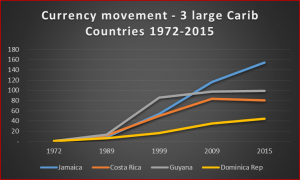


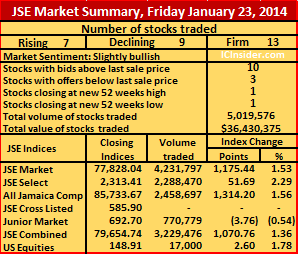







Minority deserves better
SOS directors released June’s quarterly results even though the JSE rules require the first report to be relased for the September quarter.
The investing public seems not to be treated with the respect it deserves. It appears that many companies thing of investors last, not recognizing that they are shareholders just like the majority owners.
The last persons seen are the first to be remembered and is equivalent to out of sight out of mind. That seems to be the case with shareholders in the Caribbean. Newly listed Stationery & Office Supplies release of the June quarterly report although not required by the Jamaica Stock Exchange is an example of good corporate governance and is to be applauded.
In Trinidad for example, there is little liquidity in that market and the directors refuse to do anything about it. In Jamaica many companies tend to stick with the minimum regulations of the stock exchange, even when the recent examples in Jamaica say how important it is to ensure that there is adequate liquidity in the market.
The current regulation for listings in Jamaica, is for new listed companies to file their first quarterly report in the quarter ending after listing. The rule is inadequate to protect investors. Information is critical for the capital market to function properly, as such investors should not have to wait more than two quarters to get a quarterly report. In 2016, there was the very poor decision by Wentworth Graham the then head of the regulatory arm of the Jamaica Stock Exchange to permit 1834 Investments to wrongly withhold the December quarterly report from the public. This was based on improper interpretation of the rules relating to the release of financial information.
Main Event release their first report in June after their January IPO.
Earlier this year Main Event issued their IPO and included interim results to September 2016, with the year end of October. The IPO was in January but it was not until June that shareholders had information on the out turn of the operations for 2016 as well as for the first quarter this year. As it turned out, profit of $60 million at the 11 month period melted down to $56.5 million for the full year. The audited report was only signed on the June 5, more than 7 months after the year end while the first quarter results were never released but the second quarter to April was released within the deadline of June 15.
The management of Stationery & Office Supplies may have had a lot to shout about with pretax profit jumping 146 percent to $20.3 million for the June quarter this year and hence the release of the results to Jamaica Stock Exchange in less than a month of listing on the Junior Market.
Under the stock exchange rules it need not have put out the six months report having been listed in August. Some persons may see it as self interest in the release, but there is no evidence of that. The release provides the investing public with pertinent information in a timely manner, on which they can make their investment decisions. The hope is that the Jamaica Stock Exchange rules will be strengthened quickly to ensure that pertinent information is release on a timely basis to the public.